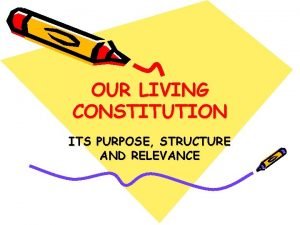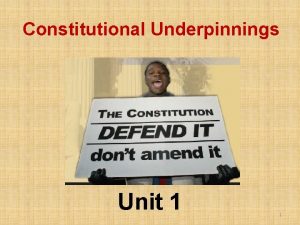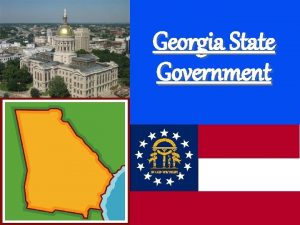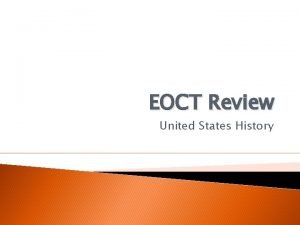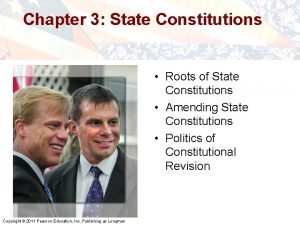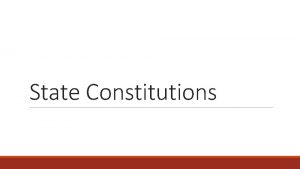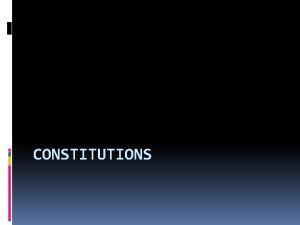First State Constitutions From Colonies to States Constitution








- Slides: 8

First State Constitutions

From Colonies to States Constitution- detailed written plan of government • Each state had a legislature o most were bicameral (÷ two parts) • Each state had a governor o elected by the people / appointed by legislature o job was to carry out laws • Each state had judges & courts to interpret the laws •

Preserving Rights Most state governments based on ideals from Declaration o “life, liberty & pursuit of happiness” • Most had a bill of rights protecting basic freedoms o jury trial o protection of personal property •

The Articles of Confederation �Forming a Confederation o individual state governments that band together for a common purpose • Articles of Confederation – first U. S. Constitution ratified, or approved, by all 13 states by 1781 o o o Set up one-house legislature, each state had one vote. Only govt that could maintain army & deal with foreign countries Had no power to enforce laws or tax

Accomplishments 1. Treaty of Paris (1783) Formally ends the war with Great Britain 2. Ordinance of 1785 – o Congress created system to survey & sell western lands o called the Northwest Territory 3. Northwest Ordinanceo laid basis for the organization of govt’s in Northwest Territory o Outlawed slavery in new territories

Weaknesses �Congress could not pass laws without the approval of 9 (of 13) states �Any attempt to amend, or change, required unanimous vote (all 13 states had to agree) �Congress had no power to collect taxes, regulate trade, or enforce its laws �No national court system existed �No single leader or group directed government policy

Time of Crisis �Debt – central & state govt’s had huge war debt State govt’s taxed citizens heavily, drove many farmers out of business taxed goods from other states & foreign countries �Shay’s Rebellion – State was going to take Shay’s farm, had not paid taxes. Shay’s felt the state had no right to punish him for the problem they had created 1, 200 farmers attacked federal arsenal Showed we need stronger federal gov’t

�Cannot settle boundary disputes �Cannot settle state disputes �Central Government cannot tax states �Every state has different currency �Foreign Distrust �No state trade regulations �Shay’s Rebellion-no central government to put down uprising
 State and federal constitutions
State and federal constitutions National government vs federal government
National government vs federal government State and federal constitutions
State and federal constitutions Texas constitution vs u.s. constitution venn diagram
Texas constitution vs u.s. constitution venn diagram Nc constitution vs us constitution
Nc constitution vs us constitution Constitution what is constitution
Constitution what is constitution Lesson 1 principles of the constitution
Lesson 1 principles of the constitution How many constitutions has georgia had
How many constitutions has georgia had What happened in 1777
What happened in 1777
